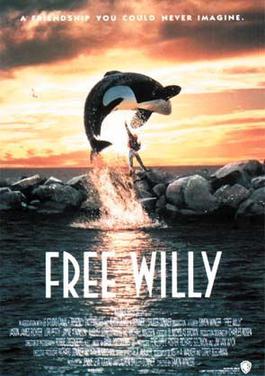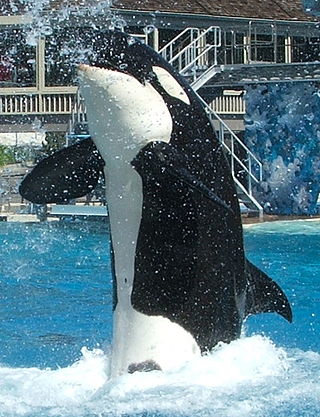
The orca, or killer whale, is a toothed whale that is the largest member of the oceanic dolphin family. It is the only extant species in the genus Orcinus. Orcas are recognizable by their black-and-white patterned body. A cosmopolitan species, they are found in diverse marine environments, from Arctic to Antarctic regions to tropical seas.

SeaWorld is an American theme park chain with headquarters in Orlando, Florida. It is a proprietor of marine mammal parks, oceanariums, animal theme parks, and rehabilitation centers owned by United Parks & Resorts. The parks host shows starring marine mammals, especially dolphins and pinnipeds, as well as zoological displays featuring various other marine animals.

Free Willy is a 1993 American family drama film, directed by Simon Wincer, produced by Lauren Shuler Donner and Jennie Lew Tugend, written by Keith A. Walker and Corey Blechman from a story by Walker and distributed by Warner Bros. Pictures under their Family Entertainment imprint. The film stars Jason James Richter in his film debut, Lori Petty, Jayne Atkinson, August Schellenberg, and Michael Madsen with the eponymous character, Willy, played by Keiko.

Orca is a 1977 American horror thriller film directed by Michael Anderson and produced by Dino De Laurentiis, starring Richard Harris, Charlotte Rampling and Will Sampson. The film follows a male orca tracking down and getting revenge on a fishing boat and its captain for killing the whale's pregnant mate and their unborn calf.
Ramu III was an Orca who resided at the now-defunct Windsor Safari Park in Berkshire, England between 1970 and 1976, and later, at SeaWorld San Diego in California between 1976 and 1986. An adult male, Ramu was caught on 8 August 1970, after his pod of eighty orcas was 'corralled' during the Penn Cove capture in Penn Cove, near Coupeville, Washington, United States. At capture, Ramu was 13.32 ft long and a member of the Southern Resident Killer Whales' L-pod. It is assumed his family members still survive in the Salish Sea and in nearby Pacific coastal waters.
Namu or NAMU may refer to:
Namu was a male orca unintentionally captured in 1965 from the C1 Pod of the northern resident community. He was the first captive orca to perform with a human in the water. He was the subject of much media attention, including a starring role in the 1966 film Namu, the Killer Whale. Namu's captivity introduced thousands of people to orcas, and soon aquariums all over the world sought to establish captive orcas in their parks.
Orcas are large, powerful aquatic apex predators. There have been incidents where orcas were perceived to attack humans in the wild, but such attacks are less common than those by captive orcas. In captivity, there have been several non-fatal and four fatal attacks on humans since the 1970s. Experts are divided as to whether the injuries and deaths were accidental or deliberate attempts to cause harm.

Springer, officially named A73, is a wild orca from the Northern Resident Community of orcas, which frequents the waters off the northern part of Vancouver Island every summer. In January 2002, Springer, then a calf developmentally equivalent to a human toddler, was discovered alone and emaciated some 250 miles from the territory of her family. Experts identified Springer by her vocal calls that are specific to her family, or "pod," and by examining photographs of her eye patch. They were also able to determine where Springer's pod was currently located.

Dozens of orcas are held in captivity for breeding or performance purposes. The practice of capturing and displaying orcas in exhibitions began in the 1960s, and they soon became popular attractions at public aquariums and aquatic theme parks due to their intelligence, trainability, striking appearance, playfulness, and sheer size. As of 24 March 2024, around 55 orcas are in captivity worldwide, 33 of which were captive-born. At that time, there were 18 orcas in the SeaWorld parks.

Orcas, also known as Killer whales, have appeared in several movies and many documentaries.
Captured in 1964, Moby Doll was the first orca to survive in captivity for more than two days, and the second to be displayed in a public aquarium exhibit. The availability, for the first time, of an orca that could be studied at close quarters alive initiated pioneering research. From a recording of Moby Doll's calls, he was years later identified as a member of J Pod of the southern resident orcas.
Edward Irving "Ted" Griffin is an American former aquarium owner and entrepreneur who was the first man to ever swim with a killer whale in a public exhibition, with the whale named Namu. He is best known for capturing, performing with, and selling a number of orcas during the late 1960s and early 1970s.
Free Willy is a media franchise from Warner Bros. that started with the 1993 film Free Willy that went on to become a sleeper hit at the box office. The original series primarily follows a street kid named Jesse who befriends an orca named Willy and eventually develops a strong connection. While trying to juggle his newly found life, he and Willy are challenged with overcoming or defeating various hazards to the ocean or Willy himself including corporate greed, hunters, poachers, and oil disasters.
The Seattle Marine Aquarium was a privately owned aquarium that was opened in 1962 and closed in 1977, and was located on Pier 56 on the Elliott Bay waterfront in Seattle, Washington, USA.
Walter the Whale (Skana) was a star orca (killer whale) during the early era of captive orcas in the 1960s. In 1967, following the death of Namu, the only other established star orca was Shamu. Walter the Whale was the orca's advertised name at first, but she was later renamed Skana.
The Yukon Harbor orca capture operation was the first planned, deliberate trapping of a large group of orcas. 15 southern resident orcas were trapped by Ted Griffin and his Seattle Public Aquarium party on 15 February 1967, in Yukon Harbor on the west side of Puget Sound. The first four orcas that had been taken into captivity had been captured singly, and mostly opportunistically. Those four were named Wanda, Moby Doll, Namu, and Shamu—who was then the only surviving one. Through them, interest in orcas had escalated.

The waters of the Salish Sea, on the west coast of North America, are home to several ecologically different populations of orcas. The area is home to three major ecotypes of orcas: northern residents, southern residents, and transients. A fourth ecotype, the offshore orcas, occasionally venture into nearshore waters as well. The different ecotypes are so named due to the fact that little direct interaction occurs between them; neither resident nor transient orcas have been observed to interbreed with one another, though occasional brief interactions do occur.







